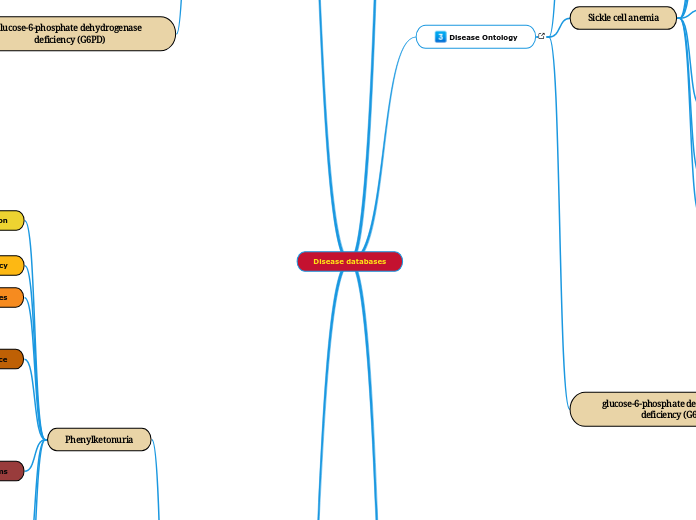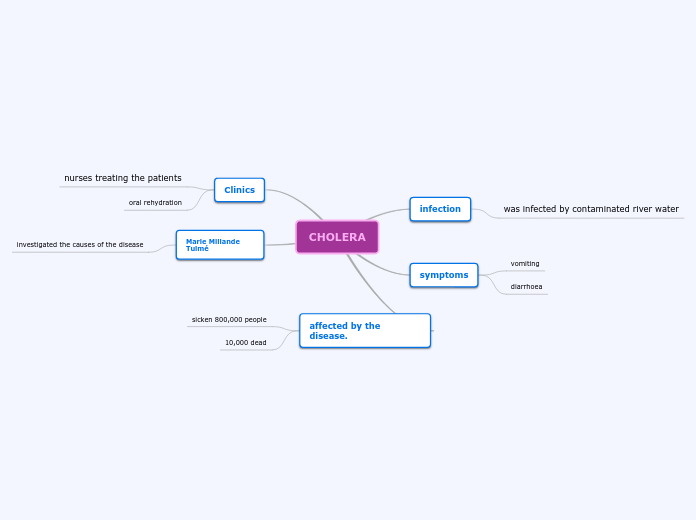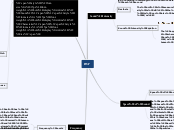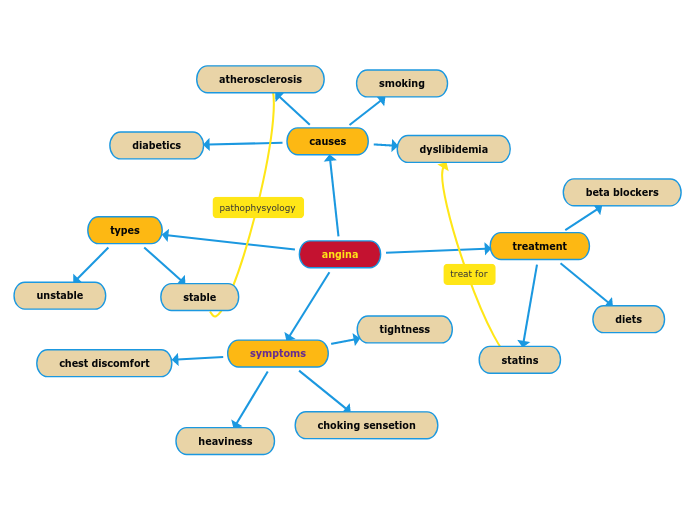Disease databases
MedlinePlus
1- paleness (in darker-skinned kids, paleness is sometimes best seen in the mouth, especially on the lips or tongue).
2- extreme tiredness or dizziness
3- fast heartbeat
4- fast breathing or shortness of breath
5- jaundice (the skin and eyes look yellow)
6- an enlarged spleen
7- dark, tea-colored pee
Treatments include medicines to treat infection, avoiding substances that cause the problem with red blood cells, and sometimes transfusions.
1- Deficiency of glucose-6-phosphate 2- dehydrogenase
3- G6PD deficiency
4- G6PDD
5- Glucose 6 phosphate dehydrogenase deficiency
X-linked
It affects about 1 in 10 African American males in the United States.
Glucose-6-phosphate dehydrogenase deficiency is a genetic disorder that affects red blood cells, which carry oxygen from the lungs to tissues throughout the body. In affected individuals, a defect in an enzyme called glucose-6-phosphate dehydrogenase causes red blood cells to break down prematurely. This destruction of red blood cells is called hemolysis.
1- a low number of red blood cells. 2- repeated infections. 3- periodic episodes of pain. 4- Painful swelling of the hands and feet
5-Fatigue or fussiness from anemia
6- A yellowish color of the skin (jaundice) or the whites of the eyes (icterus)
Treatments
bone marrow or stem cell transplantation. For the transplant to work, the bone marrow must be a close match. Usually, the best donor is a brother or sister.
1- HbS disease
2- Hemoglobin S disease
SCD
3- Sickle cell disorders
4- Sickling disorder due to hemoglobin S
Population Frequency
Occur in 1 in 500 African Americans and 1 in 1,000 to 1,400 Hispanic Americans.
Sickle cell disease is a group of disorders that affects hemoglobin. People with this disease have atypical hemoglobin molecules called hemoglobin S, which can distort red blood cells into a sickle, or crescent, shape.
1- permanent intellectual disability 2- delayed development 3- behavioral problems 4- psychiatric disorders 5- lighter skin and hair than unaffected family members 6- skin disorders such as eczema
Diet of low-protein foods is the best treatment. There are special formulas for newborns. For older children and adults, the diet includes many fruits and vegetables. It also includes some low-protein breads, pastas, and cereals.
1- Deficiency disease, phenylalanine hydroxylase
2- Folling disease
3- Folling's disease
4- PAH deficiency
5- Phenylalanine hydroxylase deficiency
6- Phenylalanine hydroxylase deficiency disease
7- PKU
Mutations in the PAH gene
occurs in 1 in 10,000 to 15,000 newborns in the United States.
Phenylketonuria (commonly known as PKU) is an inherited disorder that increases the levels of a substance called phenylalanine in the blood.
OMIM
chromosome X, q 28
asymptomatic
G6PD, Hemolytic anemia
X-Linked
results from mutations in the G6PD gene.
Different variants of G6PD are found in high frequency in African, Mediterranean, and Asiatic populations
Glucose-6-phosphate dehydrogenase (G6PD; EC 1.1.1.49) plays a key role in the production of ribose 5-phosphate and the generation of NADPH in the hexose monophosphate pathway. Because this pathway is the only NADPH-generation process in mature red cells, which lack the citric acid cycle, a genetic deficiency of G6PD (300908) is often associated with adverse physiologic effects
chromosome 11, p 15.4
- Increased susceptibility to bacterial infections
- Resistance to falciparum malaria infection - stroke -joint and leg pain
pathogenesis
HbS has a lower oxygen affinity than normal Hb and polymerizes upon deoxygenation, creating red blood cells that are distorted, resulting in a sickled appearance; adherent, leading to vasoocclusion; and fragile, leading to hemolysis. The clinical consequences of the vascular occlusion are variable, but include bone pain, deep venous thrombosis, acute chest syndrome, and stroke. In an aortic ring bioassay
- Sickle cell anemia
- Anemia, chronic
- Hemolysis
- Hypoxemia
- Leukocytosis
Caused by mutation in the hemoglobin beta gene (HBB, 141900.0243)
The estimated number of worldwide annual births of patients with sickle cell anemia is 217,331
Sickle cell anemia is a multisystem disease associated with episodes of acute illness and progressive organ damage. Hemoglobin polymerization, leading to erythrocyte rigidity and vasoocclusion, is central to the pathophysiology of the disease, but the importance of chronic anemia, hemolysis, and vasculopathy has been established.
diagnosis
Ramus et al. (1992) used PCR amplification of the low levels of mRNA resulting from illegitimate transcription of the PAH gene in fibroblasts and Epstein-Barr virus-transformed lymphocytes to detect mutations in patients with PKU.
chromosomal location
chromosome 12, q 23.2
symptoms
evere behavioral disturbances, including psychotic disorders, autistic features, hyperactivity, and aggression, as well as self-mutilation
treatments
Phenylketonuria is treatable by a low phenylalanine diet.
synonyms
PHENYLALANINE HYDROXYLASE DEFICIENCY
PAH DEFICIENCY
OLIGOPHRENIA PHENYLPYRUVICA
FOLLING DISEASE
mode of inheritance
causes
is a result of mutations in the PAH gene.
population frequency
PKU occurs in about 1 in 10,000 births
Phenylketonuria (PKU) is an autosomal recessive inborn error of metabolism resulting from a deficiency of phenylalanine hydroxylase. an enzyme that catalyzes the hydroxylation of phenylalanine to tyrosine, the rate-limiting step in phenylalanine catabolism.
RareDisease
If doctors suspect a person is G6PD-deficient, they will conduct a variety of blood tests to confirm a diagnosis and rule out other conditions that cause similar conditions.
most G6PD-deficient persons are asymptomatic most of the time; however, any one of them, when exposed to certain triggering factors, can develop acute hemolytic anemia (AHA), which may be life-threatening especially in children.
Treatment may involve medicines to treat infection, stopping drugs that are causing red blood cell destruction, and/or transfusions, in some cases.
1- G6PD deficiency
2- G6PD
3- Hemolytic anemia due to G6PD deficiency
Subtopic
caused by an alteration (mutation) in the G6PD gene.
About 10%-14% of African-American males are affected.
Glucose 6 phosphate dehydrogenase (G6PD) deficiency is a hereditary condition in which red blood cells break down (hemolysis) when the body is exposed to certain foods, drugs, infections or stress. It occurs when a person is missing or has low levels of the enzyme glucose-6-phosphate dehydrogenase.
Diagnoses
1- newborn blood spot screen
2- blood smear looking for sickled cells
3- protein electrophoresis
1- bone pain 2- chest pain 3- severe infections (primarily in children) 4- low levels of circulating red blood cells (anemia). 5- yellowing of the skin (jaundice).
1- for hypoxia, dehydration, and acidosis. They improved with oxygen and fluids.
2- Opiods to manage pain.
3- antibiotics to underlying bacterial infections from acute chest syndrome.
4- blood transfusion
5- for children= penicillin & polysaccharide vaccine
6- bone marrow transplant
7- gene therapy
SCD
Causes by defective hemoglobin A (HbA), a mutation in HBB Gene so B-globin is misshapen
1- 0.6 % of the African American population in the United States. 2- one in every 300 – 500 African American newborns.
It is a genetic disease which red blood cells take the shape of sickle, and that change allowed them to easily be destroyed, causing anemia
1- weak and feed poorly. 2- vomiting. 3-irritability, and/or a red skin rash with small pimples. 4- severe intellectual disability. 5- psychiatric disorders. 6- seizures.
1- diet low in phenylalanine that required to use amino acid based medical food or formula. 2- severe restriction of dietary natural protein intake. 3- two FDA-approved drugs are also available from the treatment of PKU.
1- classical phenylketonuria
2- hyperphenylalanemia
3- phenylalanine hydroxylase deficiency
4- phenylalaninemia
5- PKU
(mutations) in the PKU gene
ranges from one in 13,500 to 19,000 newborns in the United States.
Phenylketonuria (PKU) is an inborn error of metabolism that is detectable during the first days of life via routine newborn screening. it is a rare metabolic disease tat lead to a severe brain disorders.
Disease Ontology
Yellowish skin, dark urine, shortness of breath.
Avoiding triggers, medications for infection, stopping offending medication, blood transfusions
Synonym
1- deficiency of G-6PD
2- Glucose-6-phosphate dehydrogenase deficiency
results from mutations in the G6PD gene
400 million people worldwide. 1 in 10 African American males in the United States.
A carbohydrate metabolic disorder that is characterised by abnormally low levels of glucose-6-phosphate dehydrogenase (abbreviated G6PD or G6PDH)
Attacks of pain, anemia, swelling in the hands and feet, bacterial infections, stroke
Vaccination, antibiotics, high fluid intake, folic acid supplementation, pain medication, blood transfusions
1- drepanocytosis
2- haemoglobin SC disease
3-Hb SC disease
4- Hb-S/Hb-C disease
5- Hb-SS disease without crisis
6- Hemoglobin S disease without crisis
7- hemoglobin SC disease
8- sickle cell anaemia
9- Sickle-cell/Hb-C disease without crisis
Mutations in the HBB gene cause sickle cell disease.
The disease is estimated to occur in 1 in 500 African Americans and 1 in 1,000 to 1,400 Hispanic Americans.
mental retardation, behavioral and movement problems, seizures, and delayed development
Treatment
diet low in phenylalanine
synonym
1- Folling's disease
2- maternal phenylketonuria
3- phenylalaninemia
4- PKU
It is due to mutations in the PAH gene, which results in low levels of the enzyme phenylalanine hydroxylase.
affects about 1 in 12000 babies. males and females are affected equally.
An amino acid metabolic disorder that is characterized by a mutation in the gene for the hepatic enzyme phenylalanine hydroxylase (PAH), rendering it nonfunctional.
MalaCards
glucose-6-phosphate dehydrogenase deficiency (G6PD)
Glucosephosphate Dehydrogenase, G6PD
1- piperaquine 2- artenimol 3- clopidorgrel 4- aspirin 5- primaquine
X-linked recessive
mutations in the G6PD gene.
1 in 10 African American males in the United States.
description
s a genetic disorder that affects red blood cells, which carry oxygen from the lungs to tissues throughout the body.
Sickle cell anemia
Blood = Peripheral Blood = Erythrocytes
1- abdominal pain 2- joint and leg pain 3- renal failure 4- increased susceptibility to bacterial infections.
1- amodiaquine 2- proguanil 3- fentanyl 4- hydromorphone 5- deferasirox
Synonyms
Sickle cell-hemoglobin c disease syndrome
Mode in inheritance
autosomal recessive
Causes
caused by mutations in the gene that tells our bodies how to make hemoglobin.
1-5/10000 (France),1-5/10000 (Germany),1-5/10000 (United States),1-5/10000 (Belgium),1-5/10000 (Europe)
A blood protein disease that is characterized by low number of red blood cells, repeated infections, and periodic episodes of pain, resulting from atypical hemoglobin molecules called hemoglobin S, which can distort red blood cells into a sickle, or crescent, shape.
Phenylketonuria
drugs and therapeutics
1- Dopamine 2- Tannic acid 3- Benzocaine 4- Melatonin 5- Serotonin
anatomical context
Liver = Liver Lobule = Hepatocytes
Symptoms
1- aminoaciduria 2- intellectual disability 3- global development delay 4- abnormal facial shape 5- microcephaly
Mode of inheritance
Autosomal recessive
Population frequency
occurs in about 1 in 10,000 births
Description
A rare inborn error of amino acid metabolism characterized by elevated blood phenylalanine and low levels or absence of phenylalanine hydroxylase enzyme. If not detected early or left untreated, the disorder manifests with mild to severe mental disability.









